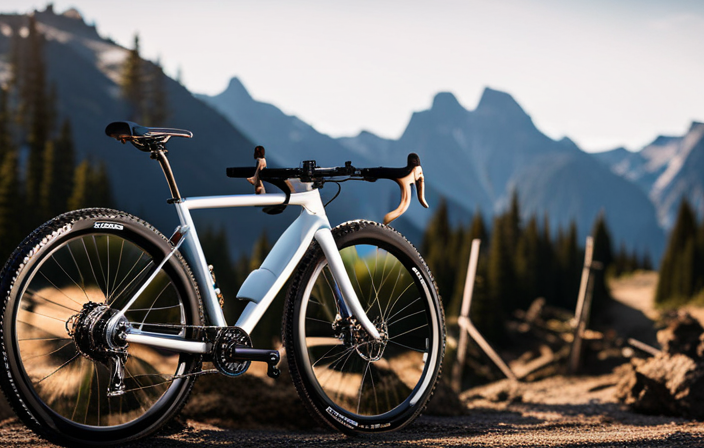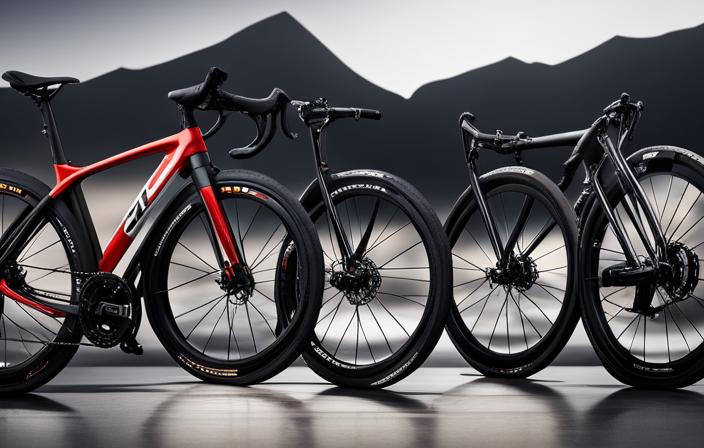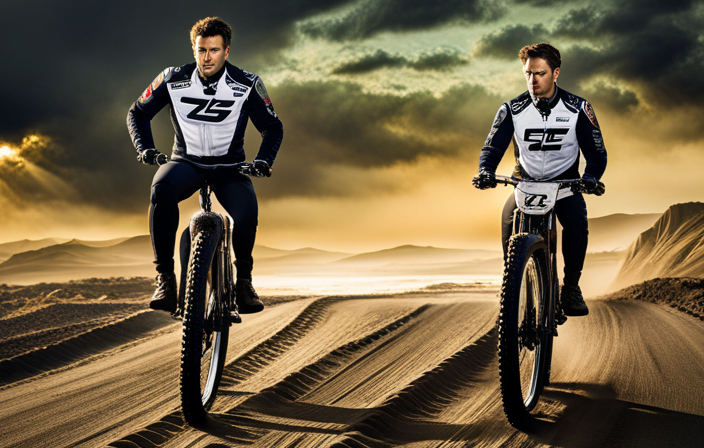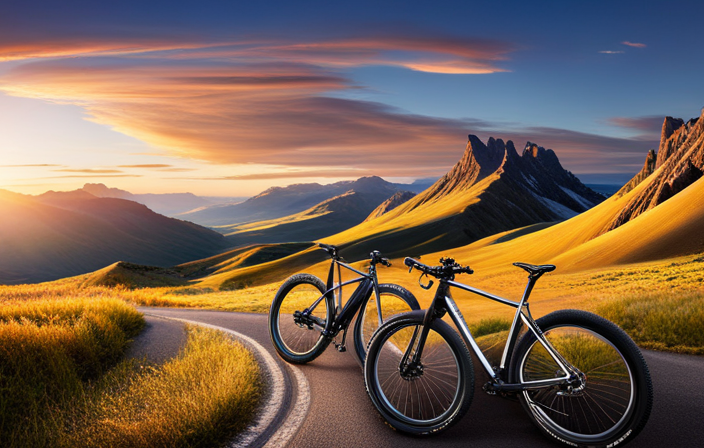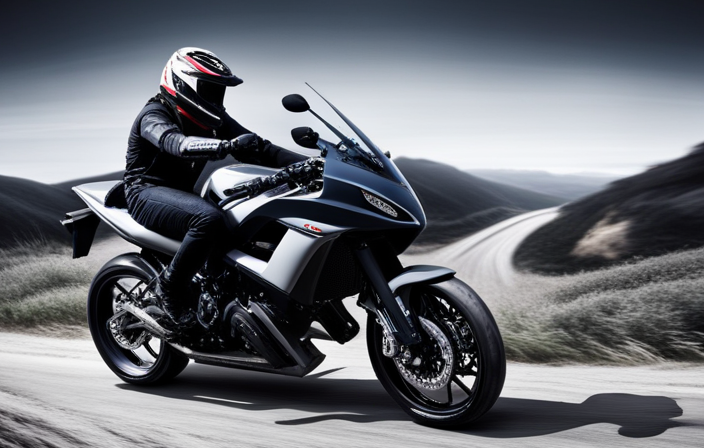Are you prepared to transfer your mountain biking expertise from trails to gravel paths?
In this article, I will guide you through the process of converting your trusty mountain bike into a versatile gravel machine.
By combining the ruggedness of a mountain bike with the speed and agility of a gravel bike, you’ll be able to tackle any terrain with confidence and ease.
So, let’s dive in and discover how to transform your MTB into the ultimate gravel companion!
Key Takeaways
- Assess frame compatibility and tire clearance before converting a mountain bike to a gravel bike
- Choose the right tires and adjust the bike’s geometry for optimal performance on different surfaces
- Upgrade the gearing system to improve speed, gear range, and overall performance on varied terrain
- Consider swapping out the suspension fork and upgrading brakes for better control and comfort on gravel roads
Assess Your Mountain Bike’s Compatibility
Assess if your mountain bike is compatible for conversion to a gravel bike. Before embarking on the process of converting your trusty MTB into a versatile gravel machine, it is crucial to evaluate its frame compatibility and tire clearance.
First and foremost, consider the frame geometry and design of your mountain bike. Gravel bikes typically have a more relaxed geometry with longer wheelbases for improved stability on varied terrain. If your MTB has a similar geometry, it could be a good candidate for conversion.
Additionally, check the tire clearance on your mountain bike’s frame and fork. Gravel tires are generally wider than those used on traditional MTBs, so ensure that your frame can accommodate the desired tire width without compromising safety or causing rubbing issues.
Once you have assessed these factors and determined that your mountain bike is compatible for conversion, you can move on to choosing the right tires for gravel riding. This step will further enhance the performance of your converted gravel bike by providing optimal traction and comfort in various conditions.
With proper assessment and careful consideration, transforming your MTB into a gravel-ready beast is within reach.
Choose the Right Tires for Gravel Riding
To make sure you have the best experience on different surfaces, it’s important to select the right tires for your gravel riding. When choosing tire pressure, keep in mind that lower pressures provide more traction and a smoother ride on rough terrain. However, if you plan on riding mostly on smoother gravel roads, higher pressures will offer better efficiency and speed. It’s essential to find the right balance between grip and rolling resistance based on your riding preferences and the type of terrain you’ll be encountering.
Another crucial factor is selecting the right tire width. Gravel tires typically range from 32mm to 45mm in width. Narrower tires are suitable for hard-packed gravel or dry conditions as they offer less rolling resistance. On the other hand, wider tires are better for loose or muddy terrain as they provide increased stability and improved traction.
Remember to consider your bike frame clearance when choosing tire width to ensure compatibility. If you’re unsure about which size fits your mountain bike, consult with a knowledgeable bike shop or seek advice from experienced gravel riders.
Now that we’ve covered selecting the right tires for your gravel riding adventure, let’s move onto adjusting your bike’s geometry for an optimized gravel biking experience.
Adjust Your Bike’s Geometry
Make sure you adjust your bike’s geometry for an optimized gravel biking experience. When converting your mountain bike to a gravel bike, it’s important to consider the differences in terrain and riding position.
First, you’ll want to adjust your bike fit to ensure comfort and efficiency on gravel roads. This includes adjusting saddle height, handlebar position, and stem length. Finding the right balance between stability and agility is key.
Next, it’s crucial to find the right gravel routes that suit your skill level and preferences. Gravel roads come in various types – from hard-packed dirt to loose gravel – so it’s essential to choose routes that align with your bike’s capabilities. Additionally, factor in the distance and elevation gain of the route to challenge yourself appropriately.
By adjusting your bike’s geometry and finding suitable gravel routes, you’ll be well-prepared for an enjoyable ride.
Now let’s move on to upgrading your gearing system, which will further enhance your gravel biking experience by providing smoother gear transitions and better performance on varied terrain.
Upgrade Your Gearing System
To upgrade your gearing system, I first installed a larger front chainring on my bike. This allowed me to achieve a higher top speed and maintain a more efficient cadence on flat roads.
Additionally, I replaced the cassette with one that had a wider gear range. This provided me with lower gears for steep climbs and higher gears for faster descents.
These upgrades greatly improved the versatility of my bike and made it better suited for gravel riding.
Install a Larger Front Chainring
Installing a larger front chainring can help convert your mtb to a gravel bike. Here are three benefits of using a larger front chainring:
-
Increased top speed: A larger front chainring allows for faster pedaling, allowing you to achieve higher speeds on flat or downhill sections.
-
Improved climbing ability: With a bigger chainring, you’ll have more mechanical advantage, making it easier to tackle steep hills and challenging terrain.
-
Better efficiency: By choosing the right size front chainring, you can optimize your cadence and find the most efficient gear ratios for your riding style.
To choose the right size front chainring, consider factors such as your fitness level, terrain, and desired riding experience. You may need to experiment with different sizes to find the optimal balance between speed and climbing ability.
Now that we’ve discussed upgrading the gearing system by installing a larger front chainring, let’s move on to replacing the cassette for a wider gear range.
Replace the Cassette for a Wider Gear Range
Replacing the cassette allows for a wider gear range, enhancing your riding experience. By swapping out the current cassette with one that has larger sprockets, you can achieve wider gear ratios. This means that you will have more options to choose from when it comes to finding the perfect gear for any terrain or riding condition.
Having a wider gear range is especially beneficial when converting your mountain bike into a gravel bike because it allows you to tackle both steep climbs and fast descents with ease. It provides smoother transitions between gears and ensures that you can maintain an optimal cadence throughout your ride. With a wider gear range, you’ll be able to conquer any gravel road or trail effortlessly.
Now let’s move on to the next step and discuss how to swap out your suspension fork.
Swap Out Your Suspension Fork
When it comes to swapping out your suspension fork on a mountain bike to convert it into a gravel bike, there are a few key points to consider.
First, opting for a rigid fork can significantly increase the efficiency and responsiveness of your bike on smoother surfaces. This will make your rides more efficient and allow you to maintain better control over the bike’s handling.
Additionally, if you still want some suspension capabilities for off-road sections or rough terrain, considering a suspension fork with a lockout feature can be beneficial. This allows you to switch between having the suspension active or locked out depending on the type of terrain you’re riding on. It gives you the versatility to enjoy both smooth rides on gravel roads and more comfortable rides when encountering bumps and obstacles.
By carefully choosing the right fork for your converted gravel bike, you can optimize its performance for different types of riding conditions while maintaining efficiency and control throughout your adventures.
Opt for a Rigid Fork for Increased Efficiency
To increase your efficiency, consider opting for a rigid fork when converting your MTB to a gravel bike. A rigid fork offers several benefits over a suspension fork, making it a great choice for gravel riding.
-
Weight reduction: A rigid fork is lighter than a suspension fork, which improves the overall weight distribution of the bike and makes it easier to handle.
-
Better power transfer: With no suspension components absorbing energy, all your pedaling power goes directly into propelling the bike forward.
-
Increased precision: The rigidity of the fork provides better handling and more precise steering on rough terrain.
-
Simplified maintenance: Rigid forks require less maintenance compared to suspension forks since they don’t have moving parts that can wear out or need regular servicing.
Considering these benefits, opting for a rigid fork can significantly enhance your gravel biking experience. However, if you prefer some suspension for added comfort on rougher trails, you may want to consider a suspension fork with a lockout feature in the subsequent section.
Consider a Suspension Fork with Lockout Feature
Consider opting for a suspension fork with a lockout feature to enhance your riding experience. Upgrading your bike’s suspension system can significantly improve its performance on gravel terrain. A suspension fork with a lockout feature allows you to switch between a fully active suspension for off-road trails and a rigid setting for increased efficiency on smoother surfaces. This versatility ensures that you can adapt your bike to different riding conditions effortlessly.
When exploring different gravel bike accessories, it is essential to consider the benefits of a suspension fork with a lockout feature. The table below compares the advantages and disadvantages of this type of fork:
| Advantages | Disadvantages |
|---|---|
| Improved comfort on rough terrain | Added weight |
| Increased traction and control | Higher cost |
| Enhanced shock absorption | Maintenance requirements |
Upgrading to a suspension fork with lockout capability will provide you with improved performance and versatility on both gravel roads and more challenging trails. Once you have selected the right fork, you can proceed to install gravel-specific accessories without compromising your riding experience.
Install Gravel-Specific Accessories
One way to convert your mtb to a gravel bike is by installing gravel-specific accessories. These accessories are designed to enhance the performance and versatility of your bike on gravel terrain. Here are some gravel bike accessories that you can consider:
- Tires: Switching to wider, knobby tires with lower tire pressure will provide better traction and stability on loose surfaces.
- Handlebars: Opt for handlebars with a wider flare, such as drop bars or flared drop bars, which offer more control and comfort when riding off-road.
- Grips: Invest in ergonomic grips or bar tape that offer extra cushioning and vibration dampening for long rides.
- Bar Ends: Adding bar ends can give you additional hand positions for improved comfort during longer rides.
By incorporating these gravel-specific accessories, you can transform your mtb into a capable gravel bike. However, it’s important to mention that adjusting your bike’s braking system is another crucial step in the conversion process. This ensures optimal stopping power and control when navigating different terrains.
Adjust Your Bike’s Braking System
When it comes to adjusting your bike’s braking system for gravel riding, there are two key points to consider.
Firstly, upgrading to disc brakes can provide better stopping power and improved performance in diverse terrain.
Secondly, installing brake pads specifically designed for gravel riding is crucial for optimal braking efficiency and durability on rough surfaces.
By making these adjustments, I can ensure that my bike is equipped with the necessary components to handle the challenges of gravel riding effectively.
Upgrade to Disc Brakes for Better Stopping Power
To improve your stopping power, you’ll want to upgrade to disc brakes on your mtb turned gravel bike. Disc brakes offer superior performance compared to traditional rim brakes, especially when riding off-road. They provide consistent and reliable braking in all weather conditions, making them ideal for gravel riding where the terrain can be unpredictable.
One of the benefits of hydraulic disc brakes is their low maintenance requirements. Unlike mechanical disc brakes, hydraulic ones are self-adjusting and don’t require frequent adjustments or pad alignment. This means less time spent tinkering with your brakes and more time enjoying your ride.
Hydraulic disc brakes also offer better modulation, allowing for precise control over braking power. With a simple squeeze of the lever, you can easily modulate your speed whether you need a quick stop or just a slight decrease in velocity.
Now that we’ve upgraded our braking system, let’s move on to installing brake pads suitable for gravel riding…
Install Brake Pads Suitable for Gravel Riding
To install brake pads suitable for gravel riding, you’ll need to choose a pad compound that provides optimal stopping power on varied terrain. Upgrading brake pads for gravel riding is crucial as it ensures your safety and control while navigating unpredictable surfaces. The right brake pad material is essential for gravel riding due to the unique demands of this type of terrain.
| Pad Material | Pros | Cons | Best Suited For |
|---|---|---|---|
| Sintered | Excellent heat resistance, long-lasting | May be noisy, can wear out rotors faster | Steep descents, wet conditions |
| Organic | Quieter braking, gentle on rotors | Less heat resistant, shorter lifespan | Casual riding, dry conditions |
| Semi-Metallic | Good heat dissipation, balanced performance | Can be noisy at times | Varied terrain |
Considering a dropper seatpost can further enhance your gravel biking experience by allowing you to quickly adjust saddle height when transitioning between different terrains without interrupting your flow.
Consider a Dropper Seatpost
Consider adding a dropper seatpost to your bike for a more versatile riding experience. A dropper seatpost allows you to quickly and easily adjust the height of your saddle while riding, which can be especially beneficial when transitioning from uphill climbs to downhill descents or tackling technical terrain. Here are three advantages of using a dropper seatpost:
-
Improved maneuverability: With the ability to lower your saddle on steep descents, you can shift your body weight back and have better control over your bike. This can greatly enhance your confidence and handling skills on challenging trails.
-
Increased comfort: By raising the saddle during climbs, you can achieve a more efficient pedaling position, reducing strain on your knees and maximizing power output. Lowering it again for descents provides relief for tired legs and minimizes the risk of hitting obstacles with your seat.
-
Enhanced safety: Being able to quickly drop your saddle out of the way allows for quicker dismounts in case of emergencies or technical sections where it’s best to have full freedom of movement.
To install a dropper seatpost, follow these general steps:
- Measure the diameter of your current seat tube.
- Choose a dropper post that matches this diameter.
- Remove the old seatpost and insert the new one according to the manufacturer’s instructions.
With a dropper seatpost installed, you’ll be ready to tackle any gravel adventure with ease! Speaking of upgrades, let’s now discuss how to install gravel-specific handlebars…
Install Gravel-Specific Handlebars
After considering a dropper seatpost for your MTB to gravel bike conversion, let’s move on to the next step: installing gravel-specific handlebars.
While flat or riser handlebars are commonly found on mountain bikes, gravel bikes often utilize drop bars for a more aerodynamic riding position.
To convert your bike’s aero handlebars into gravel handlebars, you’ll need to make a few adjustments. Start by removing the bar tape and any components attached to the handlebars, such as shifters and brake levers. Carefully detach the handlebars from the stem using an Allen wrench.
Next, install the new gravel-specific handlebars onto the stem, aligning them with your desired angle and width. Make sure they are securely tightened using an appropriate torque wrench.
Once the new handlebars are in place, reattach your shifters and brake levers according to their manufacturer’s instructions. Ensure that they are positioned ergonomically for comfortable access while riding.
Finally, wrap fresh bar tape around the handlebars for added grip and cushioning during long rides. This will also provide a clean finish to your bike’s new setup.
With your newly installed gravel-specific handlebars, you’re one step closer to transforming your MTB into a capable gravel bike. Now let’s discuss how upgrading your pedals can further enhance performance and control on different terrains.
Upgrade Your Pedals
Once you’ve installed gravel-specific handlebars, upgrading your pedals can further enhance performance and control on different terrains.
Upgrading your pedals is a great way to improve power transfer and efficiency while riding your converted gravel bike. There are several options available when it comes to pedal upgrades, such as clipless pedals or flat pedals with larger platforms.
Clipless pedals are a popular choice among gravel riders as they provide a secure connection between the shoe and pedal, allowing for efficient power transfer. They also offer adjustable tension settings, which allow you to customize the amount of force required to release your foot from the pedal.
Flat pedals with larger platforms are another option that provides stability and grip for more technical terrain.
When upgrading your pedals, it’s important to consider maintenance tips to ensure longevity and optimal performance. Regularly inspecting the bearings for wear and tear is essential, as well as cleaning and lubricating them if needed. It’s also recommended to periodically check the tightness of the pedal spindle and replace any worn-out cleats if you’re using clipless pedals.
With upgraded pedals in place, you’ll have improved control over different terrains on your converted gravel bike. Now, let’s move on to the next section about checking and adjusting your bike’s suspension settings.
Check and Adjust Your Bike’s Suspension Settings
To optimize your ride quality, make sure to check and adjust the suspension settings on your bicycle. The suspension plays a crucial role in absorbing shocks and impacts from rough terrain, providing you with a smoother and more comfortable ride. Here are three key steps to adjusting your bike’s suspension settings:
-
Adjusting the sag: Sag refers to how much the suspension compresses under the rider’s weight when stationary. To find the right sag setting, first, measure the distance between a fixed point on your bike frame and an easily identifiable point on your fork or shock. Then, sit on your bike in a natural riding position while someone else measures that same distance again. Ideally, you should aim for around 25-30% sag for mountain biking and slightly less for gravel riding.
-
Fine-tuning rebound: Rebound controls how quickly the suspension extends back after being compressed. Finding the right rebound setting is essential for maintaining control over rough terrain. Start by setting it in the middle of its range and gradually increase or decrease it until you feel comfortable over bumps without experiencing excessive bouncing.
-
Finding optimal tire pressure: Adjusting tire pressure can greatly affect how well your suspension performs. Higher pressures provide better rolling efficiency on smooth surfaces but reduce grip and comfort on rougher terrain. Conversely, lower pressures increase traction and comfort but may result in sluggish performance on smoother trails.
Considering adding a suspension seatpost can further enhance your ride comfort by providing additional cushioning between you and your bike’s frame.
Now let’s move on to consider adding a suspension seatpost as another way to improve your gravel riding experience.
Consider Adding Suspension Seatpost
Adding a suspension seatpost can greatly enhance the comfort of your ride on rough terrain. It provides additional cushioning and absorbs shocks, allowing for a smoother and more enjoyable gravel biking experience. However, before deciding to add a suspension seatpost to your bike, it is important to consider both the benefits and drawbacks.
The benefits of using a suspension seatpost are numerous. Firstly, it helps to reduce fatigue by absorbing vibrations and impacts from uneven surfaces. This means less strain on your body, especially during long rides. Secondly, it improves traction by keeping your rear wheel in contact with the ground at all times, enhancing control and stability. Additionally, a suspension seatpost can help prevent back pain that may occur when riding over bumpy terrain.
On the other hand, there are some drawbacks to be aware of. Suspension seatposts add weight to your bike, which may not be desirable for those looking for maximum speed or efficiency. They also require regular maintenance and adjustments to ensure optimal performance.
When choosing the right suspension seatpost for your gravel bike, consider factors such as travel length (the amount of vertical movement), adjustability options, and compatibility with your bike’s frame size and seat tube diameter.
In conclusion, adding a suspension seatpost can significantly improve comfort while riding on rough terrain. However, it is important to carefully weigh the benefits against the drawbacks before making a decision. Next section: "Installing a gravel-specific saddle"
Install a Gravel-Specific Saddle
Consider installing a saddle specifically designed for gravel riding to optimize your comfort and support during your off-road adventures. A gravel bike saddle is designed with the unique demands of off-road riding in mind, providing you with the necessary cushioning and stability for long hours on rough terrain.
Here are three gravel bike saddle options that you should consider:
-
Ergonomic Design: Gravel-specific saddles often feature a wider shape and shorter nose compared to traditional road saddles. This design helps to distribute your weight more evenly, reducing pressure points and discomfort during long rides.
-
Enhanced Padding: Gravel riding can be bumpy, so a saddle with additional padding can provide extra shock absorption. Look for models with gel or foam padding that offer improved cushioning without sacrificing support.
-
Durable Materials: Gravel-specific saddles are typically made from tough materials like synthetic leather or durable fabrics that can withstand the rigors of off-road riding. These materials are also resistant to water and mud, ensuring longevity even in challenging conditions.
By investing in a gravel-specific saddle, you’ll experience enhanced comfort and stability on your off-road adventures. Once you’ve found the perfect saddle, it’s time to test and fine-tune your bike’s performance to ensure optimal performance while tackling gravel trails.
Test and Fine-Tune Your Bike’s Performance
Once you’ve installed a gravel-specific saddle, it’s important to test and fine-tune your bike’s performance for optimal riding on off-road terrain. To ensure a smooth and comfortable ride, start by experimenting with different tire pressures.
Gravel riding requires a balance between grip and rolling resistance, so try adjusting the air pressure in your tires to find the sweet spot. Lower pressures provide better traction on loose surfaces but can increase the risk of pinch flats, while higher pressures reduce rolling resistance but may result in a harsher ride.
Another aspect to consider is handlebar width. Wide handlebars offer more control and stability on rugged trails, allowing for better maneuverability through tight corners. However, they may feel less comfortable or restrict your ability to navigate narrow paths. By trying out various handlebar widths, you can find the ideal balance between comfort and control that suits your riding style.
By testing these variables and fine-tuning your bike’s setup according to personal preference, you’ll be able to fully enjoy the benefits of your new gravel bike! Whether it’s tackling challenging terrains or embarking on long-distance adventures, you’ll have a machine optimized for off-road exploration.
So go ahead and hit those gravel roads with confidence!
Enjoy Your New Gravel Bike!
To fully appreciate your new gravel bike, take it out for a spin and relish the joy of off-road exploration. Here are three key things to consider when enjoying your new gravel bike:
1) Gravel Bike Maintenance: Regular maintenance is essential to keep your gravel bike in top shape. Clean your bike after each ride, paying special attention to the drivetrain and brakes. Inspect the tires for any cuts or punctures and make sure they are properly inflated. Lubricate the chain regularly to prevent rusting and improve performance. Additionally, check all bolts and screws for tightness to ensure nothing comes loose during your rides.
2) Finding the Best Gravel Routes: One of the best things about owning a gravel bike is discovering new off-road routes. Research local gravel roads, trails, or even abandoned railroad tracks in your area that are suitable for biking. Join online cycling communities or forums where you can connect with fellow riders who can recommend their favorite routes. Experiment with different terrains such as dirt paths, rocky trails, or muddy tracks to truly experience what your gravel bike is capable of.
3) Exploring with Confidence: As you venture into unfamiliar terrain on your new gravel bike, it’s important to ride with confidence but also be cautious. Stay aware of potential hazards such as loose rocks, tree roots, or potholes that could cause accidents or damage to your bike. Always carry essential tools like a spare tube, tire levers, pump, and a multi-tool kit in case you encounter any mechanical issues during your ride.
By following these tips for gravel bike maintenance and finding the best routes, you’ll be able to fully enjoy every adventure on your new off-road companion!
Frequently Asked Questions
Can I convert any mountain bike into a gravel bike?
Yes, any mountain bike can be converted into a gravel bike. Converting an MTB to a gravel bike involves making some modifications. These modifications include changing the tires to wider, smoother ones and adjusting the gearing for better performance on gravel roads.
The benefits of gravel biking are numerous. First, it increases versatility, allowing you to ride on a variety of terrains. Second, it enhances comfort on rough surfaces, thanks to the wider tires that provide more cushioning. Lastly, gravel biking allows you to explore more diverse terrain types, opening up new adventure possibilities.
One of the great advantages of gravel biking is that it allows you to enjoy off-road adventures while still maintaining speed and efficiency on paved surfaces. This means you can transition seamlessly between gravel roads and paved roads without sacrificing performance.
In summary, converting an MTB into a gravel bike is a great way to expand your cycling options and enjoy the benefits of both off-road and on-road riding.
How much does it cost to convert a mountain bike into a gravel bike?
Converting a mountain bike to a gravel bike can vary in cost depending on the components you choose. The cost of new components, such as tires, handlebars, and drivetrain, can range from $200 to $500 or more.
However, the benefits of converting are worth it. A gravel bike offers a more versatile riding experience with improved stability on different terrains, making it ideal for long rides or exploring off-road trails.
Do I need to be an experienced cyclist to convert my mountain bike into a gravel bike?
Being an experienced cyclist certainly helps when converting a mountain bike into a gravel bike. However, it’s not a prerequisite for success.
In fact, the beauty of beginner-friendly conversions is that they allow riders of all skill levels to venture into the world of gravel biking. With the right tools and resources, anyone can transform their trusty MTB into a versatile gravel machine.
So don’t be discouraged if you’re new to cycling – give it a try and enjoy the advantages of exploring new terrains!
Can I still ride my converted gravel bike on mountain bike trails?
Yes, you can ride your converted gravel bike on mountain bike trails. However, it’s important to understand the differences between mountain biking and gravel biking.
Gravel bikes are designed for long rides on mixed terrain, with wider tires and a more upright riding position. Mountain bike trails often have rougher terrain and require more suspension and aggressive tread patterns.
While your converted gravel bike may handle some moderate trails, it may not be suitable for advanced or technical mountain biking.
Are there any safety considerations when converting a mountain bike into a gravel bike?
When converting a mountain bike into a gravel bike, safety should be the top priority. To ensure a smooth and secure ride, it’s crucial to choose the right components.
Start by selecting wider tires with a smoother tread pattern for improved stability on gravel surfaces. Additionally, consider installing disc brakes for better stopping power.
Other safety measures include adjusting your bike’s geometry and fitting it with appropriate accessories like fenders and lights for enhanced visibility on roads.
Conclusion
In conclusion, transforming my mountain bike into a gravel machine was a thrilling adventure. Assessing compatibility and choosing the right tires were the first steps. Adjusting geometry, upgrading the gearing system, and swapping out the suspension fork followed. Considering a suspension seatpost and installing a gravel-specific saddle were also important considerations. Finally, fine-tuning performance completed the process.
The result? A marvelous metamorphosis from rugged off-roader to agile gravel glider! Every pedal stroke on those winding gravel paths now feels like floating on a feathered cloud. Gravel grinding has never been so gratifying!
